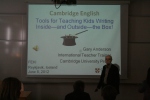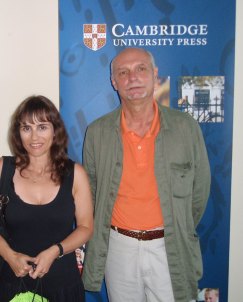Make your Teacher’s Book thine own when teaching a new course
I was in Turkey last month: in the east, at Erzurum at the foot of Palandöken Mountain (with the best ski slopes in Turkey, so they say), and in the south in Adana and its surrounding region. I was mostly doing post-adoption training for teachers who have adopted a Cambridge English course for the new academic year: courses such as Kid’s Box and Super Minds for primary and More!, Your Space and Interactive for secondary.
Now I only had an hour or so for each session with different groups of teachers and you can’t do much in-depth training in that limited amount of time. So we talked about the underlying  methodology of the course, and looked at the overall course structure and how (and why) a unit is put together. Of course we discussed ideas for teaching a lesson, including supplementing the coursebook with downloadables available on the different Teacher’s Zones at http://www.cambridge.org/elt, for example. We also talked about sharing the wealth of ideas and experience by adding activities drawn from colleagues, or even your own, because you teach the class, not just the coursebook, right?
methodology of the course, and looked at the overall course structure and how (and why) a unit is put together. Of course we discussed ideas for teaching a lesson, including supplementing the coursebook with downloadables available on the different Teacher’s Zones at http://www.cambridge.org/elt, for example. We also talked about sharing the wealth of ideas and experience by adding activities drawn from colleagues, or even your own, because you teach the class, not just the coursebook, right?
But I insisted that we also look at the teacher’s books accompanying each course. Why? Because I know that whenever I started teaching a new coursebook, I would always use the teacher’s book for its wealth of information and ideas. I’d take a good look at its answers (a time-saver and to avoid trouble-makers), and its suggested groupings and timings for each exercise. I’d run through its ideas for warm-up and extension activities, and advice on teaching mixed-ability classes – after all, every class is a mixed-ability class, isn’t it? I’d even work my way through the tape- and video-scripts all the way through to the supplementary photocopiable activities in the back!
I pointed out to the teachers in Turkey that there’s almost always a lot of white space on the pages of teacher’s books. You can use that space to customize and make the teacher’s book your own. You can write in comments and add Post-its next to individual activities as reminders of what worked or didn’t. You can remind yourself of how much more or less time an activity took than the guess-estimate given. You can add ideas on what to supplement the activity or lesson with, and with advice and reminders on what to do differently – or the same – the next time you teach that activity or lesson.
All this personalising the textbook takes us back to the title of this post, and in particular to a word that may have been unfamiliar to you: ‘thine’. Older forms of English used to have two different forms of the second person possessive: ‘your’ for the ‘plural’, and ‘thy’ for the singular (or ‘thine’ when used in front of a vowel). My suggestions for personalizing your teacher’s books can be  understood as a way of making ‘your’ teacher’s book (that is, the one everyone uses) into ‘thine own’ individual, personal and on-going teaching document!
understood as a way of making ‘your’ teacher’s book (that is, the one everyone uses) into ‘thine own’ individual, personal and on-going teaching document!
What about you? Do you look at and use the teacher’s books, especially when starting with a new coursebook? How do you personalise your teacher’s book(s)? Looking forward to seeing your votes in the above poll and to reading and replying to your comments.
Gary Anderson, Cambridge ELT International Teacher Trainer



 Posted by internationalteachertrainer
Posted by internationalteachertrainer 










